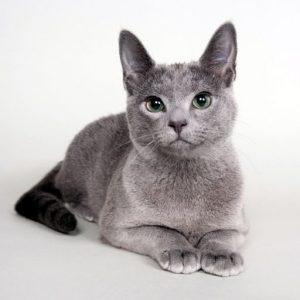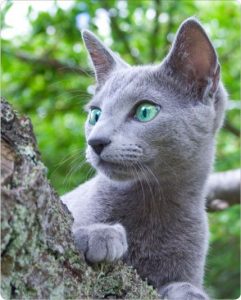


Origin
Russia
History
A naturally occurring breed, the Russian Blue is said to have first emerged in Arkhangelsk, a Russian port city facing the White Sea. Legend has it that this grey beauty thrived in the Russian wilderness and was hunted for its dense fur. Today, grey cats looking very similar to the Russian Blue are still present in the coldest areas of the country.
This feline was previously called “Archangel Cat” in a nod to its place of origin. Its luxurious coat and glittering green eyes reportedly drew the favour of the royalty and the wealthy. As such, it has become the pet of some Russian czars. After sailors took this cat on their voyages, the Russian Blue started arriving at other shores, particularly European ones.
It arrived in Great Britain in the 1860s. Then, in 1875, it was featured in one of the first cat shows in the world. The exhibition was held at the Crystal Palace in London, which marks the first time the breed was recorded outside its native country.
In 1912, the Russian Blue was entered in competition with other blue cat breeds. It was also the year when the Governing Council of the Cat Fancy (GCCF) gave it its own class and was named “Foreign Blue.” It was also known then as the Maltese. Later, in 1948, this breed’s name was changed to Russian Blue.
During World War II, the breed nearly died out as breeders were no longer unable to develop it further. After the war ended, cat fanciers from European countries, including Britain, attempted to save the breed. As there were very few Russian Blues, they crossed the feline with blue point Siamese and British Blue Shorthairs. Eventually, these crossbred traits were bred out of the Russian Blue as it rose in numbers. Its gene pool remains healthy.
Personality
The Russian Blue cat is arguably one of the most beautiful and coveted cats in the world. One of its biggest selling points is its impeccable appearance. Few cats rival the Russian Blue in beauty. However, it is not all beauty and no brains. The Russian Blue is loved equally for its pleasant personality, making it a much adored pet worldwide.
The Russian Blue is the blue-blooded feline in the cat world with its lean elegance and aristocratic look. It is considered as one of the most intelligent cat breeds in the world. It is affectionate and loyal to its owners and is known to follow them around the house.
As the name implies, the Russian Blue cat originated in the country of Russia. In fact, the Russian Blue is sometimes referred to as the Archangel Cat, in a nod to its presumed origin in the Archangel Isles. It is thought to have moved out of Russia and into other European countries like England by boat in the 19th century. Upon moving around the continent of Europe, the Russian Blue cat began to travel with their owners to other corners of the world as well.
In appearance Russian Blue cat is lean and finely proportioned. However despite its slender physique, the Russian Blue cat is actually quite strong and muscular. A gorgeous coat covers its body. The Russian Blue cat has a double coat that is short and quite soft to the touch. The coat is primarily a rich and dusky blue, however it is silver at the tips, giving the Russian Blue cat a very regal appearance. In addition to the striking coat, the cat has intensely large, green eyes that add further mystique to its appearance.
In personality, the Russian Blue is thought to be very pleasant and friendly. They are shy in the beginning but warm up to their owners and become loving companions. Additionally, they are known for being very intelligent, and easily get along with kids and pets.
The Russian Blue cat’s personality should not be taken for granted however. It does not take kindly to loud environments or a lack of stability. But in a kind and loving household, the Russian Blue cat makes a great pet.
- This cat is a loyal, affectionate, and gentle pet that thrives as an indoor cat as long as its routine and environment are consistent.
- The Russian Blue takes time to warm up to strangers and is shy with unfamiliar people.
- It likes to follow its owner around the house but is not demanding or very vocal.
- Its dense fur is easy to maintain, only requiring weekly brushings.
- The Russian Blue is healthy, being one of the very few breeds with no known hereditary health risks.
Did You Know?
Did you know cat hair isn’t the cause of reactions by people sensitized to cat allergens? The primary cause is an allergen produced in cats’ saliva. These allergens are spread to cats’ hair through grooming, which are then shed into the environment.
Appearance & Coat






